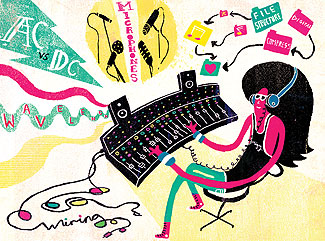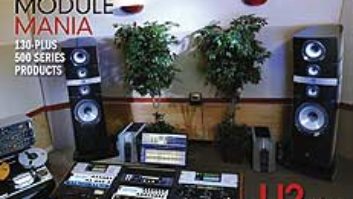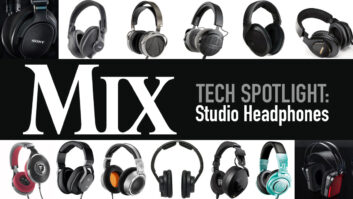
Illustration: www.migy.com
Time travel has always been possible — at least in print journalism. In this case, I’m writing about an AES panel discussion that’s happening in a few days, although you’re reading about it after the event. Moderator Michael Stucker (Indiana University, Jacobs School of Music) titled this workshop “Teaching Electronics to Audio Recording Students — Why Bother?” In addition to myself, the panelists include Walter Sear (Sear Sound), Bill Whitlock (Jensen Transformers), Dale Manquen (MANCO) and Eric Brengle (Swinghouse Studios).
I do believe that audio recording/production students should learn basic electronics. But it’s important to bear in mind that class size, range of student interest and allocated credit hours (as well as whether classes are required or elective) will always affect the scope of what “basic” electronics courses can be offered.
Sonic Haberdashery
Engineers have always worn many hats, so familiarity with disciplines such as acoustics, power distribution, electronics, music and even psychology are key, if only to facilitate better communication with specialists in those fields. Of course, time plays a critical role in the choices of courses that students and educators can make — not only in terms of how much time a student has (i.e., a 2- or 4-year program), but also as it relates to the student’s temperament. There are exceptions to every rule, but in my experience, the more focused students have put some distance between themselves and high school. What a difference four years can make.
In the program where I teach, the prerequisite math class includes a very basic electronics lab — just enough so that students can mate reality with Ohm’s Law. A battery, a resistor, an LED and a multimeter may not be audio, but it’s hands-on, and that’s essential.
The class I teach is officially titled Studio Maintenance, but in essence it’s bare-bones electronics. The textbook, Teach Yourself Electricity by Stan Gibilisco, starts with a two-chapter overview of chemistry and physics. Three labs familiarize students with a multimeter, various electronic components and their schematic symbols. By week four, students are stuffing a power supply board for their class project — an active DI that becomes a full-fledged mic preamp in a future class. Along the way, circuits are explained and the Internet is exploited daily.
The Time-Space Discontinuum
Students in the 19 to 29 age group have an attention span of about 20 minutes. Each activity — lab segments and especially lecture time — should fit into this time window. A stopwatch is not necessary; it’s all in the eyelids — an indication that it’s time to stand up, grab some lab materials and start touching stuff.
I try to balance the practical with technical aspects, inviting students to bring in their broken stuff (and hope the problems are simple enough to inspire and boost confidence early on). This is not so much “electronics” — it’s a crash course in what not to fear and what to look for, such as broken wires, cold solder joints, burned components and the ever-elusive blown fuse.
Times 10
Class meets twice a week for 10 weeks — 60 hours total — averaging about 60 students per year; it’s an elective within a two-year production program. Other technically oriented classes offered by our program include Live Sound (where cable making is part of the hands-on experience) and Acoustics (another elective). When we succeed in teaching receptive students how to learn, 60 hours is enough to launch the more serious ones into orbit. Of those who come just to build the DI, one step into reality and they quickly realize how a few basic skills can expedite the journey from unpaid intern to paid employee.
In five years of teaching, five of my students (8 percent) have emerged as extremely capable, employable and/or self-sufficient, exploiting technical skills that few others have. Of that group, a few have opted into a four-year EE degree program and returned as guest lecturers. (In a classic four-year EE program, several semesters are devoted to math alone, with little hands-on and even less audio-specific class time.)
A similar percentage barely pass my class, yet they learned something; the acquired fine motor skills alone are worth the price of admission. Overall, the percentage of students who stay in touch is larger, especially thanks to LinkedIn and Facebook.







